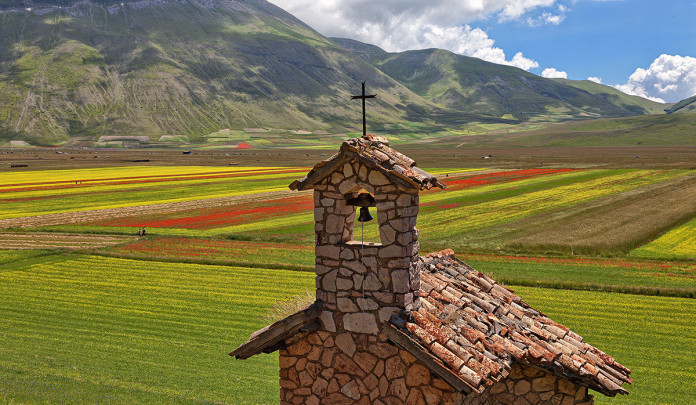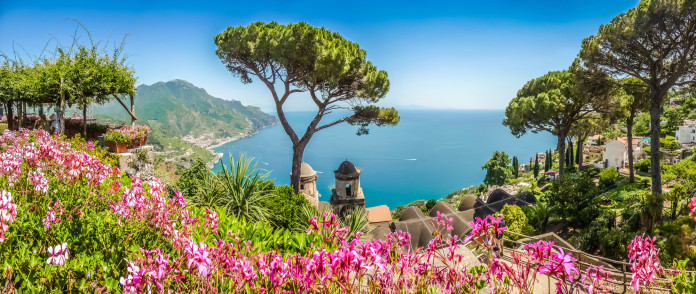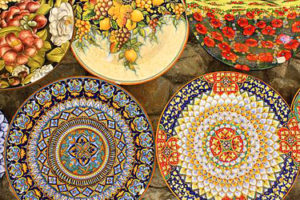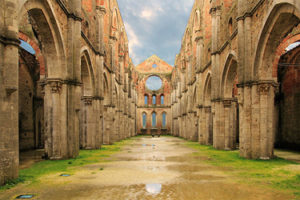Umbria is a historic and cultural melting-pot. It’s one of the smallest regions of Italy and keeps clear traces of its past. The Umbria of “saints”, of “warriors” and of “green”: all these words describe this place, but it’s not enough. Perugia and all other cities and towns of Umbria can offer to visitors an artistic and cultural patrimony, and ancient landscapes. This is a region where the traditions, the fairs and the celebrations have a very important meaning: they preserve diversity, local costumes and traditions that the globalisation try to pull down. We suggest you 10 towns to visit in Umbria to discover art and culture of this little but big region
If you are looking for a hotel in the Umbria, we suggest you to choose among those offered by Booking.com. There are about 720 hotels with prices, pictures and comments of guests already stayed there. Go to Booking.com
Perugia in Umbria
1
Perugia is a little jewel that visitors discover slowly. This town has artistic and monumental treasures of a rich past.
It looks like a small fortified medieval village, but Perugia has a very busy city life. There is one of oldest University of the Studies of Italy (founded in 1308), as well as the biggest University for foreigners in Italy.

So it’s not a city full of tourists during the day and empty at night. There are a lot of monuments to visit: from the National Gallery to the Etruscan Well (Pozzo Etrusco), the Oratory of San Bernardino to Corso Vannucci. The remain is a surprise you’ll discover by yourself.
Assisi in Umbria
2
Assisi is one of the most visited cities of Umbria. Here were born two important Saints of Italian history: Saint Francis (San Francesco) and Saint Clare (Santa Chiara). That’s why this is one of the main destination of pilgrims every year. The modern city was built without damaging the structure of the old one: some little streets connect the squares which are disposed on different levels of the city .

The St. Francis’ Basilica and Saint Clare’s church deserve a visit, but you should also visit: The Minerva ‘s Temple, or the Palace “Capitano del popolo” and the huge “Rocca Maggiore”, that is just outside the old walls of the city. We suggest you to visit also Regional Park of the Mount Subasio, you’ll enjoy a beautiful landscape and the wonderful natural heritage of this region.
Gubbio in Umbria
3
Gubbio was built on calcareous stones, that’s why it is called “grey city”. It’s the most ancient centre of the region and both the buildings and the streets have their medieval appearances. Gubbio has a uniform and sublime panorama. As for Assisi, Gubbio’s history is linked to St. Francis: the legend tells that in this city the Saint met a ferocious wolf which took shelter in St. Francis church.

Piazza Grande (“The Big Square”) is the centre of this town, you can begin from here your tour of Gubbio. The principal monuments are Palazzo dei Consoli , Palazzo del Capitolo, the Cathedral and the Church of Santa Maria dei Servi… they will tell you the history and the legends of Gubbio.
Todi in Umbria
4
Todi is an elegant medieval town, one of the most charming cities in Umbria. It rises, austere and melancholic, on the top of a hill overlooking the Tiber valley. Walking through the streets of Todi you’ll breathe an atmosphere of past.

In Piazza del Popolo, which was the ancient seat of the Roman forum, you could visit the Cathedral, the Palazzo dei Priori, the Palazzo del Capitano and Palazzo del Popolo. They’re all symbols of the powerful past of this town. In this square you could alternate cultural visits to lovely pauses in the beautiful cafés or give a look to the typical workshops to buy the beautiful hand-made cloths. And don’t forget to taste the wine, Todi has a glorious wine tradition. Outside the city walls, at the bottom, there is the Temple of Our Lady of Consolation (Santa Maria della Consolazione). It’s famous all around the world and considered one of the symbolic buildings of the Italian Renaissance.
Orvieto in Umbria
5
Spoleto is a medieval small village but has Roman origin . The Roman theatre, Druso’s Arch and the pre-Christian Basilica of San Salvatore have the most ancient origins.

The main monument of this city is the fortress built by the cardinal Albornoz during the second half of 1300. The Eroli’s Chapel and the Relic’s Chapel are two attractions that you should not miss: in the first one you could admire the beautiful frescoes made by the Pinturicchio, while the latter keeps a beautiful statue of the Virgin with child of the XIV century.
In the centre of the city there’s the majestic Cathedral and near it the Palazzo Arroni and the church of Santa Maria della Manna d’Oro. Spoleto is also the city of an important cultural festival: the “Festival dei due mondi”: a show made of movies, theatre, art, music and ballet.
Spello in Umbria
6
Spello is located on a rocky spur of the Mount Subasio. The pink stone of the Mount Subasio gives to the town a wonderful colour. As for Spoleto, Spello keeps the marks of its Roman origins, but its medieval structure is still visible too.

The remains of the Amphitheatre and of the Theatre are visible inside the ancient walls of the town. The Porta Consolare and the Porta Urbica are in a perfect state of preservation. Walking through the little streets of the centre you can also admire the ancient buildings and the castles, even if they have been modified during the centuries. Spello is an important town of the past, but it’s known also for its “infiorata”: a festival that takes place every year, during the religious festivity of Corpus Domini. In those days the artists crowd the streets of Spello showing their works made with flowers’ petal and inspired by religious events.
Terni, Marmore waterfall in Umbria
7
Terni is placed in a big valley, where the river Serra and the river Nera meet. It’s a city opened to the future but it doesn’t forget its glorious past. You can find ancient monuments such as San Salvatore church and the Romanesque Cathedral and you can see also the futuristic tower that rise over the Palazzo Comunale Vecchio.

You can’t miss the Marmore Waterfall: few kilometres from Terni you could see one of the most spectacular sights of this area. The Marmore Waterfall , which is an artificial waterfall created by the Romans, was made to drain the river Velino. Its total height is 165 meters and you’ll love the foaming waters and their games of light
Clitunno Springs in Umbria
8
These springs are the main attraction of the landscape in Umbria. They are underneath springs that run from Spoleto to Foligno for 60 km ending into a tributary of the Tiber.

Their aspect is very suggestive thanks to the nature that reflects into the river. This place has been inspiration for many writers and artists. In the past people believed that in these waters the god Clitunno lived.
Nowadays you can find also a temple with ancient frescoes . The emperor Caligula used to come here for oracle’s prophecies, and it seems that ancient religious rites took place here.
Spoleto in Umbria
10
Spoleto is a medieval small village but has Roman origin . The Roman theatre, Druso’s Arch and the pre-Christian Basilica of San Salvatore have the most ancient origins. The main monument of this city is the fortress built by the cardinal Albornoz during the second half of 1300.

The Eroli’s Chapel and the Relic’s Chapel are two attractions that you should not miss: in the first one you could admire the beautiful frescoes made by the Pinturicchio, while the latter keeps a beautiful statue of the Virgin with child of the XIV century.
In the centre of the city there’s the majestic Cathedral and near it the Palazzo Arroni and the church of Santa Maria della Manna d’Oro. Spoleto is also the city of an important cultural festival: the “Festival dei due mondi”: a show made of movies, theatre, art, music and ballet.
Norcia in Umbria
9

Norcia is famous for two main reasons: San Benedetto and the gastronomy. San Benedetto was the first monk of the Christianity, he founded the Benedictine ordination; the Basilica, dedicated to him, is dated back to XIV century, but it has been restored many times. The gastronomy has the typical flavours of the mountains products, this is another good reason to visit the city.
Food makes Norcia famous in all the world: truffle, spelt, lentils and cheeses. In a word: this jewel offers to its visitor the chance to enjoy beautiful historical visits with tasty gastronomic experiences. Inside the ancient walls of this city you can also visit the Cathedral, the Castellina and the Civic Museum.
If you are looking for a hotel in the Umbria, we suggest you to choose among those offered by Booking.com. There are about 720 hotels with prices, pictures and comments of guests already stayed there. Go to Booking.com




























































